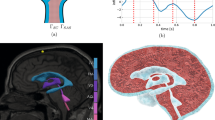Abstract
The mathematical model of human intracranial hydrodynamics proposed in a previous paper is here used to simulate the results of some dynamical tests of great clinical and physiological value and to analyze the blood flow pattern in the intracranial human basal arteries (especially in the internal carotid artery). Peak to peak amplitude of the blood flow waveform in the intracranial basal arteries, computed through the model, shows a significant increase at intracranial pressure levels above 50–60 mmHg, in accordance with recent experimental data. Moreover, diastolic blood flow appears to be largely sensitive to intracranial pressure changes during severe intracranial hypertension, whereas systolic blood flow is only slightly affected in this condition. The response of intracranial pressure to typical saline injection (volumepressure response, steady state infusion and bolus injection tests) and to an abrupt obstruction in the extrancranial venous drainage pathway is also well reproduced by the model. Finally, alterations in these responses, due to changes in some significant intracranial hydrodynamical parameters (i.e., the intracranial elastance coefficient and CSF outflow resistance) are presented.
Similar content being viewed by others
References
Aaslid, R.; Markwalder, T.M.; Nornes H. Noninvasive transcranial Doppler ultrasound recording of flow velocity in basal cerebral arteries. J. Neurosurg. 57: 769–774; 1982.
Avezaat, C.J.J.; van Eijndhoven, J.H.M. The role of the pulsating pressure variations in intracranial pressure monitoring. Neurosurg. Rev. 9: 113–120; 1986.
Avezaat, C.J.J.; van Eijndhoven, J.H.M.; Wyper, D.J. Cerebrospinal fluid pulse pressure and intracranial volume-pressure relationship. J. Neurol. Neurosurg. Psych. 42: 687–700; 1979.
Baumbach, G.L.; Heistad, D.D. Regional segmental and temporal heterogeneity of cerebral vascular autoregulation. Ann. Biomed. Eng. 13: 303–310; 1985.
Belardinelli, E.; Gnudi, G.; Ursino, M. A simulation study of physiological mechanisms controlling cerebral blood flow in venous hypertension. IEEE Trans. Biomed. Eng. 32: 806–816; 1985.
Cuypers, J.; Matakas, F.; Potolicchio, S.J. Effect of central venous pressure on brain tissue pressure and brain volume. J. Neurosurg. 45: 89–94; 1976.
Eijndhoven van, J.H.M.; Avezaat, C.J.J. The CSF pulse pressure as indicator of intracranial elastance: The role of the pulsating changes in cerebral blood volume. In: Ishii, S.; Nagai, H.; and Brock, M. eds. Intracranial Pressure V. Berlin, Heidelberg: Springer-Verlag; 1983: pp. 191–196.
Eijndhoven van, J.H.M.; Avezaat, C.J.J. Cerebrospinal fluid pulse pressure and the pulsatile variation in cerebral blood volume: An experimental study in dogs. Neurosurgery 19: 507–522; 1986.
Ekstedt, J. CSF hydrodynamic studies in man: Method of constant pressure CSF infusion. J. Neurol. Neurosurg. Psych. 40; 105–119; 1977.
Ekstedt, J. CSF hydrodynamic studies in man. 2: Normal hydrodynamic variables related to CSF pressure and flow. J. Neurol. Neurosurg. Psych. 41: 345–353; 1978.
Giulioni, M.; Ursino, M.; Gallerani, M.; Cavalcanti, S.; Paolini, F.; Cerisoli, M.; Alvisi, C. Epidural pressure measurement in the rat. J. Neurosurg. Sci. 30: 177–181; 1986.
Harders, A. Neurosurgical applications of transcranial Doppler sonography. New York: Springer-Verlag, Wien; 1986.
Harper, S.L.; Bohlen, G.; Rubin, M.J. Arterial and microvascular contributions to cerebral cortical autoregulation in rats. Am. J. Physiol. 246: H17-H24; 1984.
Hillen, B.; Gaasbeek, T.; Hoogstraten, H.W. A mathematical model of the flow in the posterior communicating arteries. J. Biomech. 15: 441–448; 1982.
Katzman, R.; Hussey, F. A simple constant infusion manometric test for measurement of CSF absorption. I: Rationale and method. Neurology (Minneapolis) 20: 534–544; 1970.
Kontos, H.A.; Wei, E.P.; Novari, R.M.; Levasseur, J.E.; Rosenblum, W.I.; Patterson, J.L. Responses of cerebral arteries and arterioles to acute hypotension and hypertension. Am. J. Physiol. 234 (4): H371-H383; 1978.
Lindegaard, K.F.; Grip, A.; Nornes, H. Precerebral hemodynamics in brain tamponade. Neurochirurgia 23: 133–142; 1980.
Lindegaard, K.F.; Grip, A.; Nornes, H. Precerebral hemodynamics in brain tamponade, part 2: Experimental studies. Neurochirurgia 23: 187–196; 1980.
Marmarou, A.; Schulman, K.; LaMorgese, J. Compartmental analysis of compliance and outflow resistance of the cerebrospinal fluid system. J. Neurosurg. 43: 523–534; 1975.
Marmarou, A.; Schulman, K.; Rosende, R.M. A nonlinear analysis of the cerebrospinal fluid system and intracranial pressure dynamics. J. Neurosurg. 48: 332–344; 1978.
Mchedlishvili, G.I. Physiological mechanisms regulating cerebral blood flow. Stroke 11: 240–248; 1980.
Mchedlishvili, G.I. Arterial behavior and blood circulation in the brain. New York: Plenum Press; 1986.
Miller, J.D.; Stanek, A.; Langfitt, T.W. Concepts of cerebral perfusion pressure and vascular compression during intracranial hypertension. In: Meyer, J.S.; Schade, J.P. eds. Progress in Brain Research. Amsterdam: Elsevier; 1972: pp. 411–432.
Nornes, H.; Aaslid, R.; Lindegaard, K.F. Intracranial pulse pressure dynamics in patients with intracranial hypertension. Acta Neurochirurgica 38: 177–186; 1977.
Rungelstein, E.B. Transcranial Doppler monitoring. In: Aaslid, R. ed. Transcranial Doppler Sonography. New York: Springer-Verlag; 1986; pp. 147–163.
Uematsu, S.; Yang, A.; Preziosi, T.J.; Kouba, R.; Toung, T.J.K. Measurement of carotid blood flow in man and its clinical application. Stroke 14: 256–266; 1983
Ursino, M. Mathematical simulation of human intracranial hydrodynamics. 1: The cerebrospinal fluid pulse pressure. Ann. Biomed. Eng. 16: 379–401; 1988.
Author information
Authors and Affiliations
Rights and permissions
About this article
Cite this article
Ursino, M. A mathematical study of human intracranial hydrodynamics part 2—Simulation of clinical tests. Annals of Biomedical Engineering 16, 403–416 (1988). https://doi.org/10.1007/BF02364626
Received:
Revised:
Issue Date:
DOI: https://doi.org/10.1007/BF02364626




